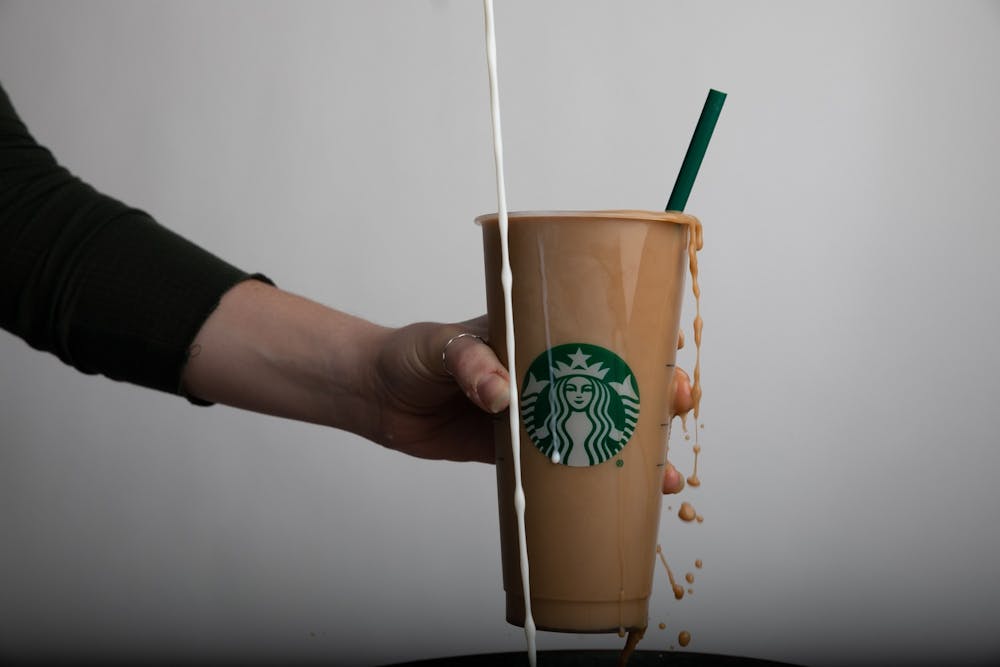
Tier Morrow is a senior journalism and English studies major and writes “Caffeinated Conversation” for The Daily News. Her views do not necessarily agree with those of the newspaper.
After Miley Cyrus and Liam Hemsworth find the sea turtle nest in the 2010 film “The Last Song,” they surround it with wooden stakes and wire fencing and set up lawn chairs, vowing to sleep outside until the eggs hatch.
If you’re like me, you were nervously yelling, “Go, go, go” at the screen as the pair fended off racoons looking for a late-night snack.
Now, think back to yesterday’s morning routine: Did you pop into Starbucks for a vanilla iced coffee or pull into the gas station for a soda? No matter what your caffeine of choice was, you probably instinctively unwrapped a straw before taking a long swig intended to get you through the day.
If you did, you might have just choked one of those baby turtles clawing its way toward the ocean.
It is estimated every person in the United States uses at least two straws a day, amounting to more than 500 million straws across the country, according to the Be Straw Free Campaign.
The campaign also reported that by 2050, “there will be more plastic in the ocean than fish (by weight).”
Sip on that for a minute.
As a progressive company, Starbucks announced in March of last year it would remove straws from 30,000 stores worldwide by 2020, starting with the implementation of a strawless lid only offered with cold brew drinks. Later, in summer 2019, the company released an official strawless cold drink lid for all cold drinks except blended options.
“It sounds dramatic, but this lid is going to get used about a billion times a year,” said Andy Corlett, director of global packaging solutions and innovations for Starbucks, who has also designed packaging for L’Oréal and Proctor & Gamble, in a press release. “It’s going to take billions of single-use plastic straws off the market.”
According to Starbucks, the new lid uses 9 percent less plastic than the former lid and straw combined, meaning there is less plastic to throw away and less plastic to end up in the oceans.
But beyond that, there is no straw, and straws are what lodge themselves in the nostrils and throats of sea turtles. Because turtles can’t regurgitate anything they eat, straws either get trapped in the wrong place and cause blockages or sit in the turtle’s stomach, slowly killing the innocent reptile.
By 2050, it is predicted 99 percent of all sea turtle species will have ingested at least one piece of plastic because straw addicts can’t give up the comfort of an unneeded straw.
My grandpa told me stories about watching sea turtles in the ocean near his North Carolina home. I’ve been to see them once myself, and I hope to one day take my children. I want to know, without a doubt, that every time I return, the majestic creatures will be there to greet me.
But that won’t happen if the people in front of and behind me in the Starbucks line continue to instinctively grab a straw before their drink despite the redesigned, strawless lid.
When we were kids, we all learned to drink from sippy cups, a similar design, and we didn’t try to stab straws through the lid, so why is there such a problem now? If you got a hot drink, you wouldn’t think about putting a straw in it either, so why do you need one for a cold drink?
I know it’s hard to quit a bad habit cold turkey, but when you go to get your grande iced caramel macchiato tomorrow morning, ask yourself if you need a plastic straw or if you can pick up a wooden stir stick and use it for its intended purpose, hence the name.
Or maybe you want to really push yourself, and you buy a reusable hot or cold drink cup Starbucks offers, and you start bringing it with you every time you need a refill. You’d be helping the planet, saving turtles and spending less money all at the same time.
I know it can be easy to get wrapped up in all the bad happening in the world and feel like you, one person, can’t do anything to make a difference, but you can. And it starts one straw at a time.
Contact Tier Morrow with comments at tkmorrow@bsu.edu or on Twitter at @tiermorrow.




